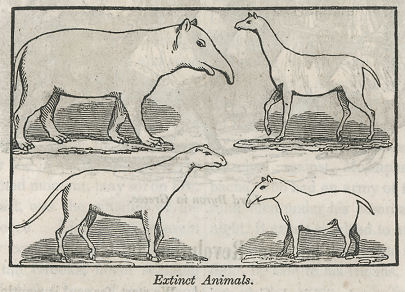“Wonders of Geology” (reprinted from work by William Buckland; from Robert Merry’s Museum, December 1848; p. 183)

More than nine thousand different animals have been changed into stone. The races or genera of more than half of these are now extinct, not being at present known in a living state upon the earth. From the remains of some of these ancient animals, it is evident that they must have been larger than any living animals now known upon the earth.
The Megatherium, (great beast,) from a skeleton, nearly perfect, now in the museum at Madrid, seems to have been colossal. With a head and neck like those of the sloth, its legs and feet exhibit the character of the armadillo and the ant-eater; its fore feet were a yard in length, and more than twelve inches wide, terminated by gigantic claws; its thigh-bone was nearly three times as thick as that of the elephant, and its tail (nearest the body) six feet in circumference. Its tusks were admirably adapted for cutting vegetable substances, and its general structure and strength were intended to fit it for digging in the ground for roots, on which it principally fed.